January finally came to an end and Spring is fast approaching. It’s the time when many gardeners plan changes to their garden and look for inspiration online. In this blog post let me inspire you to introduce beautiful Hydrangeas into your sacred space. They bloom beautifully and are easier to grow than you may think. They also easily fill up the space and come in so many colors and shapes that everybody will find something to their liking. If I caught your attention, let me show you arrangements that I found online.
As said above Hydrangeas are quite easy to grow. They’re versatile, low-maintenance shrubs that can thrive in a variety of garden settings if given the right conditions. Here’s a quick guide to their growing requirements:
1. Light Requirements
- Morning Sun & Afternoon Shade: Most hydrangeas prefer partial sun, meaning 4–6 hours of direct sunlight in the morning with afternoon shade, especially in hot climates.
- Full Sun Tolerance: Some varieties, like Panicle Hydrangeas (Hydrangea paniculata), can handle full sun but require more frequent watering.
2. Soil Conditions
- Well-Draining & Rich Soil: Hydrangeas need moist but well-drained soil. Heavy clay soil can cause root rot, while sandy soil dries out too quickly. Amend the soil with compost or organic matter for better moisture retention and aeration.
- pH Levels & Bloom Color:
- Acidic soil (pH below 6.0) = Blue flowers
- Neutral to alkaline soil (pH 6.5+) = Pink flowers
- White hydrangeas remain the same color regardless of soil pH
3. Watering Needs
- Hydrangeas have shallow roots, so they dry out quickly. They need 1-2 inches of water per week, especially during hot weather.
- Water deeply in the morning to encourage strong root growth. Avoid overhead watering to prevent fungal diseases.
- Mulch (2–3 inches of organic mulch) helps retain moisture and regulate soil temperature.
4. Temperature & Climate
- Hydrangeas are hardy in USDA zones 3-9, depending on the variety.
- They prefer cool to mild climates, with protection from harsh afternoon sun in warmer regions.
- Winter Protection: In colder zones, mulch around the base to protect roots from freezing. Some varieties, like Bigleaf Hydrangea (Hydrangea macrophylla), may need burlap or extra insulation in harsh winters.
5. Fertilizing
- Spring & Summer Feeding: Use a balanced, slow-release fertilizer (e.g., 10-10-10) in early spring and again in midsummer.
- Avoid high-nitrogen fertilizers, as they promote leafy growth but fewer blooms.
6. Pruning Guidelines
- Bigleaf & Oakleaf Hydrangeas: Bloom on old wood, so prune lightly after flowering.
- Panicle & Smooth Hydrangeas: Bloom on new wood, so prune in late winter or early spring.
- Climbing Hydrangeas: Require minimal pruning, just remove dead or weak stems.
With proper care, hydrangeas reward gardeners with spectacular, long-lasting blooms throughout the growing season!
Please remember that each variety may have slightly different needs so before buying the plant, always check if You are able to give it conditions optimal for growth.
1. Hydrangea Annabelle and Hosta Combo
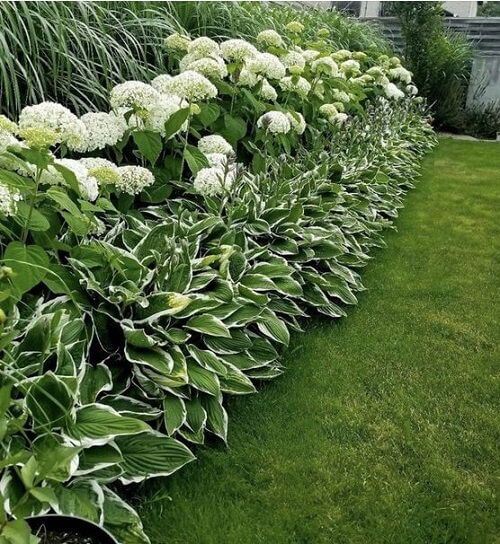
I often see this combination in many gardens. At the very back we have tall grass working as a background. In the middle we have white Hydrangea Annabelle and at the very front we see Hostas working as the edge for this flower bed. We have only two colors here: white and green, which creates a very uniform and minimalistic look. It’s perfect for people who don’t want to spend too much time on their garden but still want some pretty flowers.
2. Layering to add depth and interest to composition
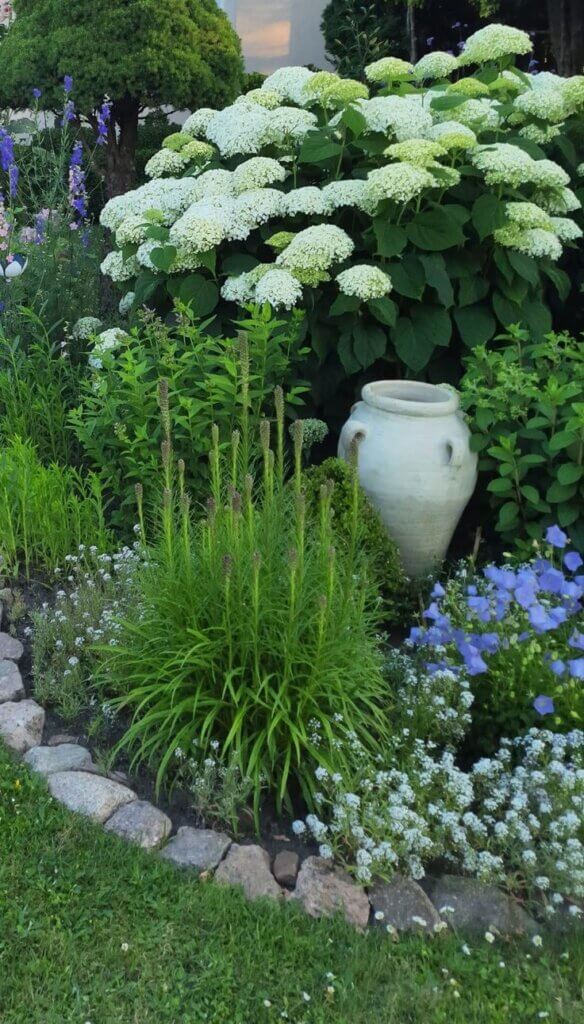
Here we have a flower bed in cottagecore style. I can bet many of you saw something like that in your grandmas’ garden. The main star of the show is Hydrangea Annabelle at the back, in front of it we see Liatris spicata – The tall, spiky green plants in the foreground with emerging flower spikes. It’s a perennial that produces vibrant purple, pink, or white flowers later in the season.
The bright blue, cup-shaped flowers on the right side of the image belong to Campanula, a lovely perennial that adds color and a soft, cascading effect.
The small white flowers forming a low border along the edge of the bed are Sweet Alyssum, a fragrant ground cover that thrives in sunny locations.
Behind the urn, there are neatly shaped green shrubs, likely Boxwood, used for structure and evergreen interest.
3. Hydrangeas as background for colorful flowers
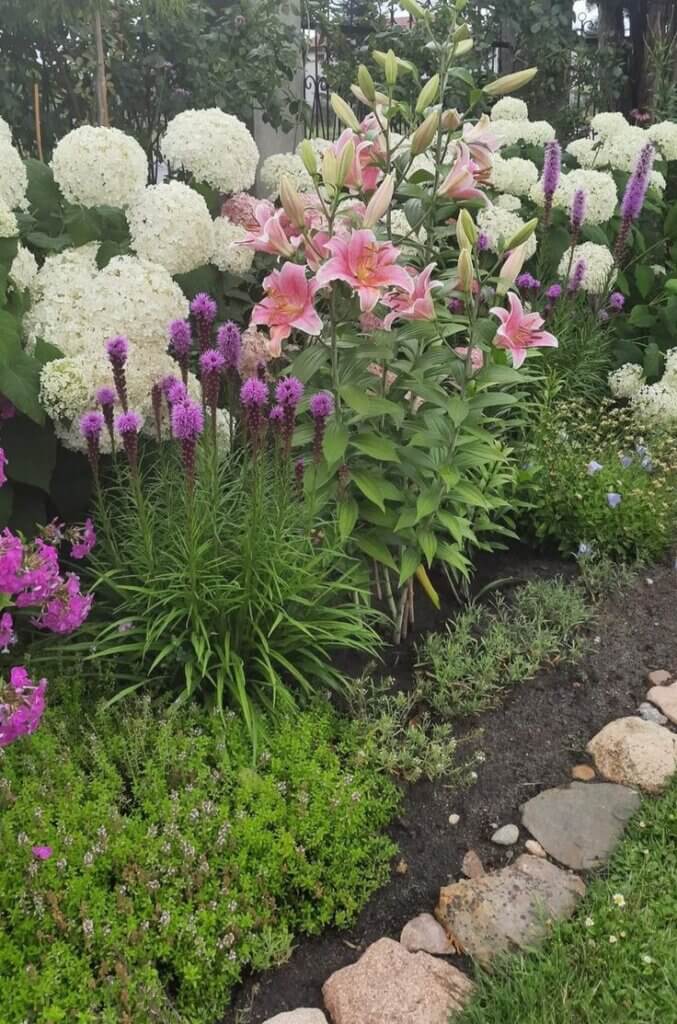
Hydrangeas due to their size often play the main role in the garden, but thanks to this size they also are perfect for backgrounds. Here once again we see Hydrangea arborescens ‘Annabelle’. Its white flowers and lush green leaves are the perfect background for more colorful flowers.
The tall pink flowers with large, trumpet-shaped blooms are lilies, adding elegance and fragrance to the arrangement. These lilies typically bloom in mid-to-late summer. The spiky, purple flowers in the middle foreground are Liatris (the same we saw in a photo above), a native perennial known for its tall, vertical flower spikes that attract pollinators.
The bright pink flowers to the left appear to be Phlox paniculata, which blooms in mid-to-late summer and is known for its long-lasting, fragrant flowers. The low-growing, dense green plant at the front of the border is likely a variety of Creeping Thyme, which serves as a fragrant ground cover.
4. Many shades of Hydrangea
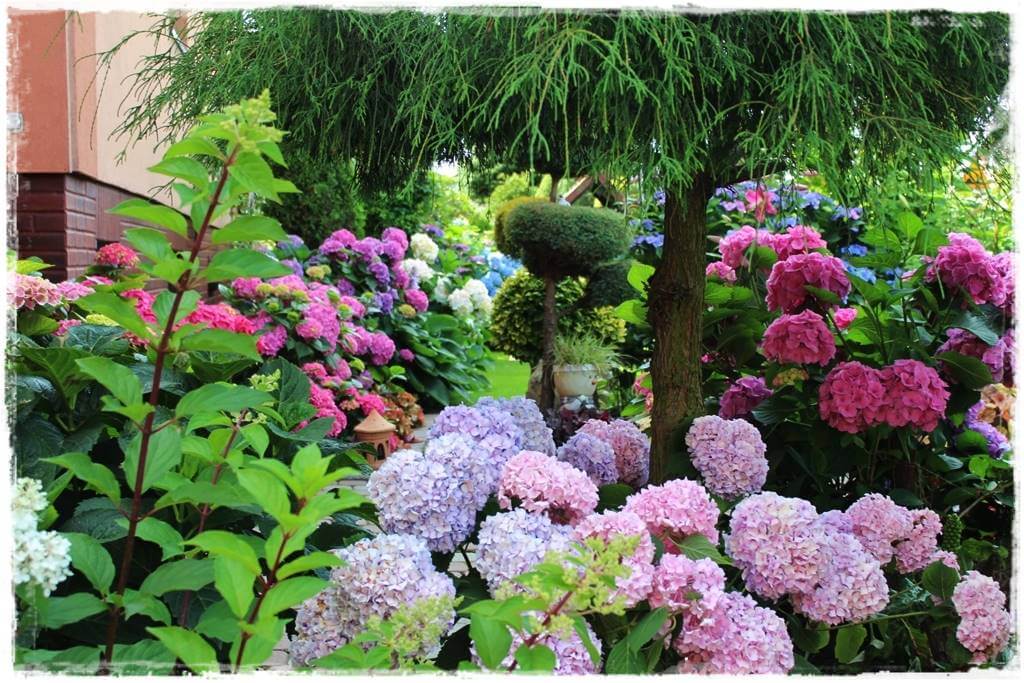
So far we saw only white Hydrangeas so I’m thrilled to show You, that they’re much more interesting than you would have thought.
The foundation of this garden features several varieties of hydrangeas, including what appear to be both mophead and lacecap varieties. The mophead hydrangeas have large, round flower clusters, some in delicate pink and others in soothing blue. This color variation isn’t just for show – it’s actually influenced by the soil’s pH level, with acidic soil producing blue blooms and alkaline soil yielding pink ones. The best part is that the acidity of the soil is completely in your control.
In the background, a graceful weeping evergreen, possibly a weeping cypress or cedar, adds architectural interest and provides a perfect dark green backdrop for the hydrangea display.
5. Hydrangeas in pots for versatility
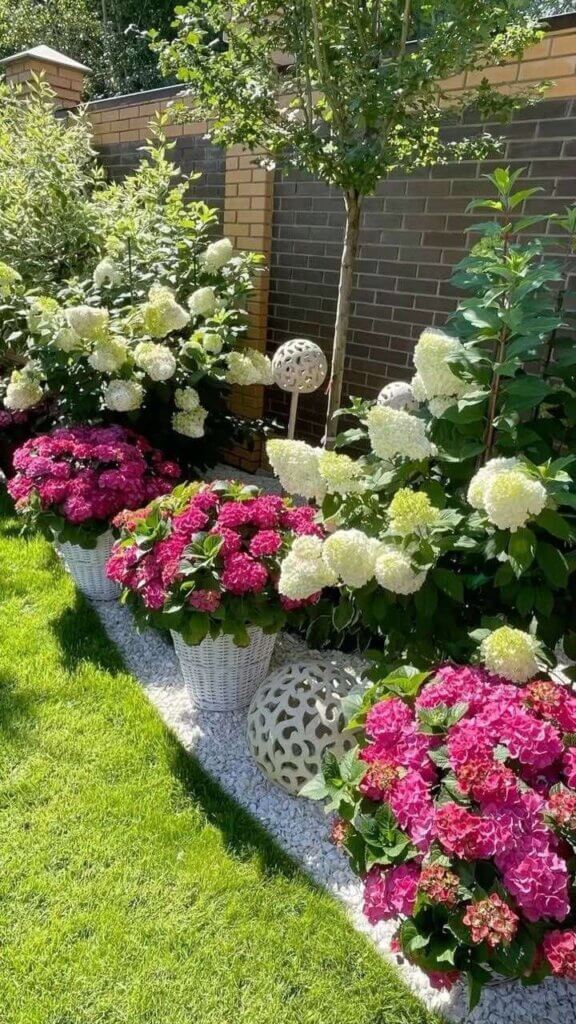
In this beautifully landscaped garden border we see Hydrangeas in two distinct colors: bright fuchsia pink hydrangeas in white wicker planters along the border and pure white hydrangeas (possibly ‘Limelight’ variety) growing as shrubs against the wall. Limelight is one of those varieties that change throughout the season. They bloom in lime green color and with passing weeks they change to pure white.
Planting your flowers in pots is a great idea, when You’re not sure where you want your plants to grow. Through the season you can check how they look in different spots in your garden and how they behave. You only need to remember to water them more often than flowers in the ground.
We also see here small ornamental tree (appears to be a young specimen, possibly a flowering pear or similar ornamental variety)
6. Hydrangeas in formal garden setup
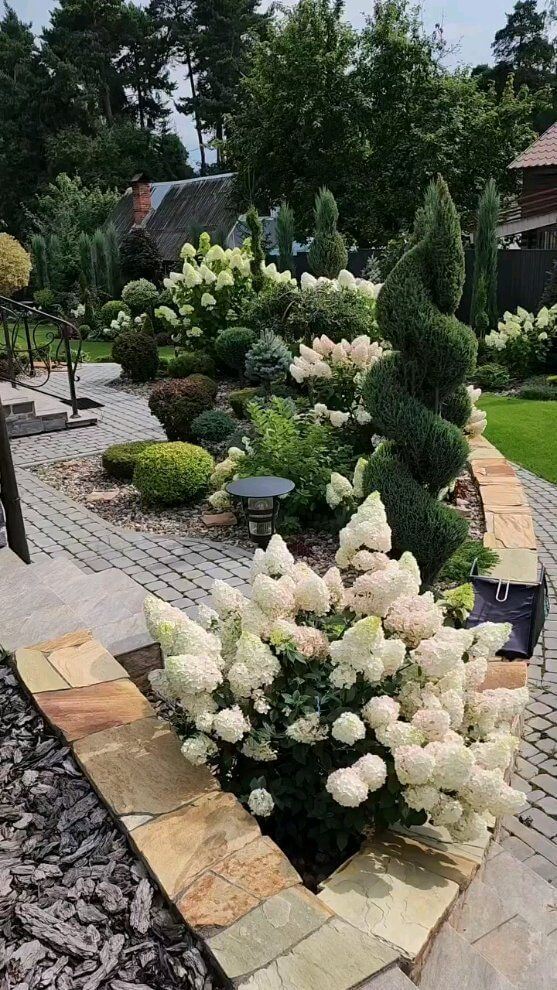
In this arrangement we see that Hydrangeas can fit into every composition, even the formal one, where structured, architectural forms of evergreens contrast with soft, billowing hydrangea blooms.
Hydrangeas used in this garden are likely ‘Limelight’ or ‘Vanilla Fraise’ varieties with large cream/white cone-shaped flower panicles in the foreground and throughout the bed.
Evergreen shrubs include:
- Juniper – tall, columnar specimens providing vertical interest
- Boxwood – rounded sphere-shaped topiaries in various sizes
- Blue Spruce – possibly dwarf varieties with silvery-blue needles
7. Hydrangeas trained as trees
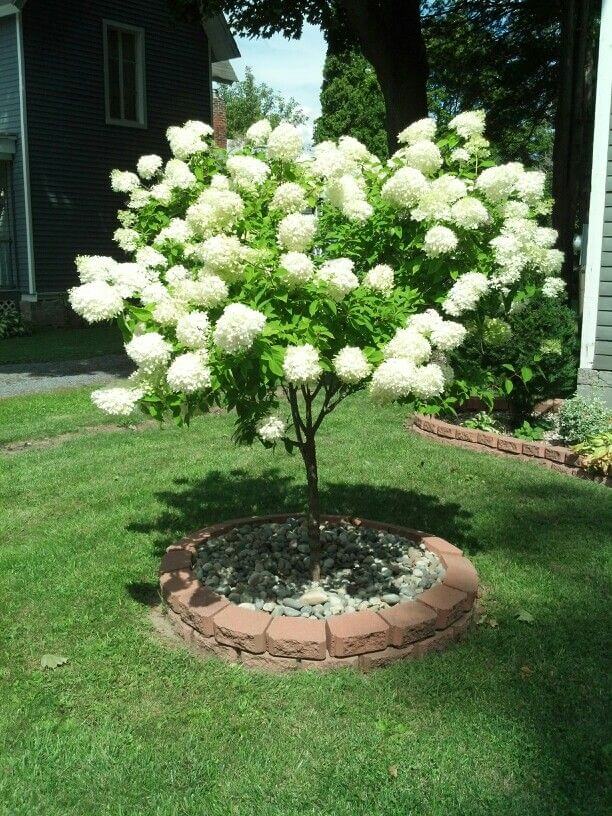
Please do not forget that Hydrangeas can be grown as trees as well as shrubs. The only secret is proper cutting. You basically choose one main stem and let it grow while cutting out all of the other stems, growing around and on the sides. It takes years to grow such a beautiful little tree, but as we can see, it’s well worth it.
You may also like: 15 The Most Beautiful Rose Garden Ideas
8. Hydrangea and Lavender flower arrangement
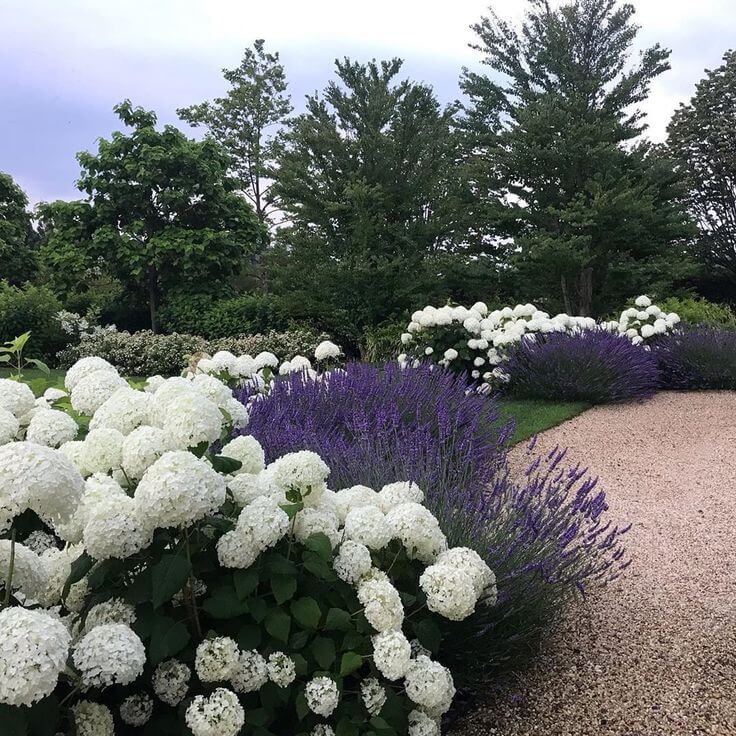
Here we have another contrasting arrangement. Already well known Hydrangea Annabelle grows together with English Lavender creating beautiful and aromatic space. Besides colors, the different flower forms (round hydrangea heads and spiky lavender) create textural interest.
9. Hydrangeas in late Summer
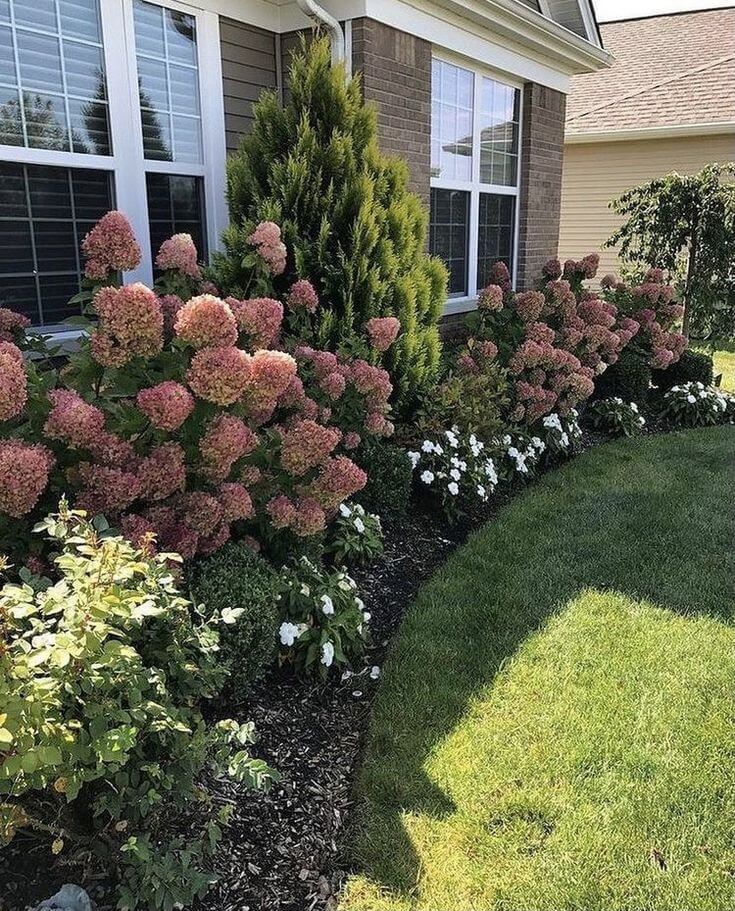
You already know that many Hydrangea varieties are like chameleons in our gardens. In this case we have Hydrangea paniculata ‘Vanilla Strawberry’ or ‘Fire Light’ which features large cone-shaped blooms in shades of pink to antique rose.
Tall, columnar evergreen providing vertical accent is probably Upright Juniper or Cypress. Low-growing white flowers are White Vinca or White New Guinea Impatiens.
10. Hydrangea transforming from white to pink
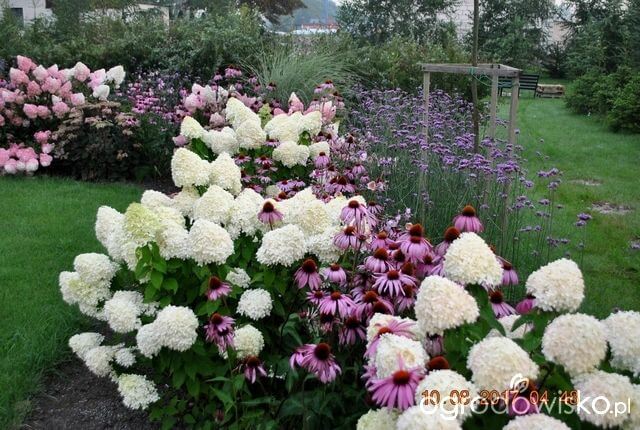
In this beautiful perennial garden border, there are three main plants creating a harmonious combination. At first we see white Hydrangea ‘Vanilla Strawberry’ variety. It’s white in the forefront, but if you look further you’ll notice that shrubs in the backdrop are changing colors to delicate pink. It combines perfectly with Purple Coneflower which provides mid-height interest and attracts pollinators.
The tall spiky purple flower stems belong to Russian Sage or Lavender. It creates an airy texture in the background and adds vertical interest to the composition.
11. Acidic fertilizer for Hydrangeas
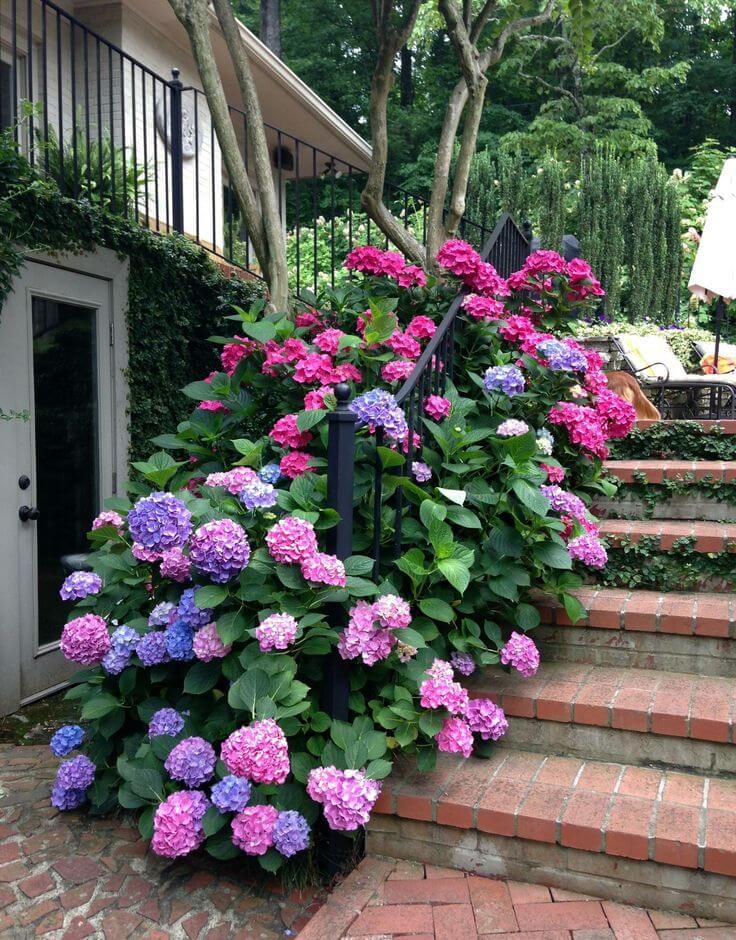
Here is another magnificent example of Hydrangea macrophylla (Bigleaf Hydrangea) in many shades of pink and blue. As I said before, the variation in color is due to soil pH, with acidic soil producing blue flowers and alkaline soil yielding pink ones.
You may wonder how do I achieve such an effect when I have only one shrub? You need to experiment. You can buy special fertilizer for Hydrangeas and dose the amount you use. If your goal is blue flowers use the amount recommended on the packaging, if you want a mix of colors like above use less and see what the results are. Write it all down and take photos for future recommendation.
12. From pink to purple
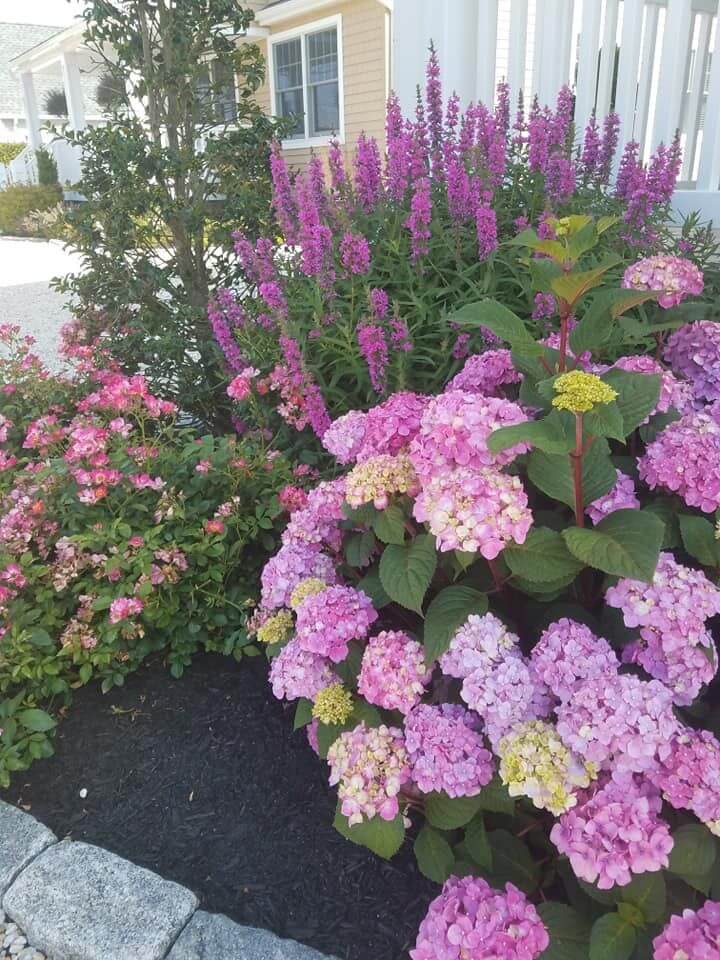
Although I love rows of hydrangeas in full bloom, I also appreciate arrangements when they just pop here and there as part of a bigger composition. Here once again we see pink Bigleaf Hydrangea but I think it’s not the main star in this flowerbed.
Just look at this Purple Loosestrife – The tall spikes of vibrant purple flowers in the background add height and contrast. They also add some drama because of how spiky it is.
The smaller pink flowers in the lower left appear to be a type of groundcover rose, adding a delicate, romantic touch to the garden bed. Pink flowers in this rose are a slightly different shade than Hydrangeas’, so it adds some depth to the composition.
13. Hydrangea tree in full bloom
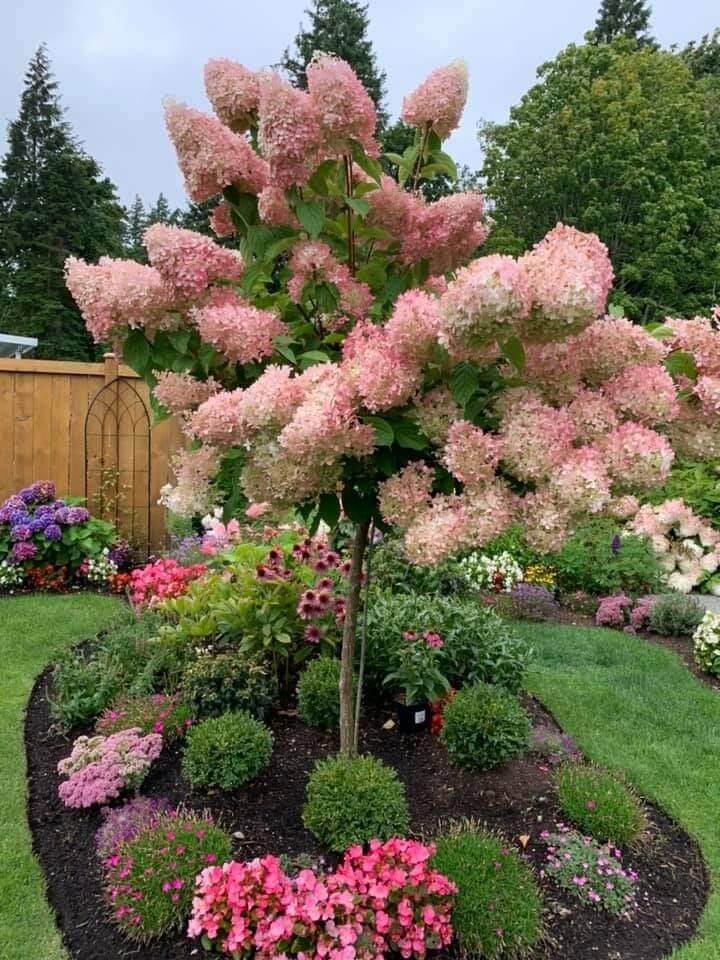
The focal point of the image is Hydrangea paniculata ‘Vanilla Strawberry’, this tree-form hydrangea has large cone-shaped flowers that transition from white to soft pink and then to a deeper pink as they mature.
In the middle of the garden bed we see Echinacea (Coneflowers), with pinkish-purple daisy-like blooms, these are popular perennials that attract pollinators. The bright pink flowers near the front of the bed, which are low-growing and compact, appear to be Begonias.
The small, neatly rounded green shrubs scattered throughout the bed are Boxwood Shrubs, they provide structure and year-round greenery. Other colorful flowers surround the base of the tree, possibly including petunias, impatiens, and other seasonal blooms.
14. Hydrangeas in English Garden setup
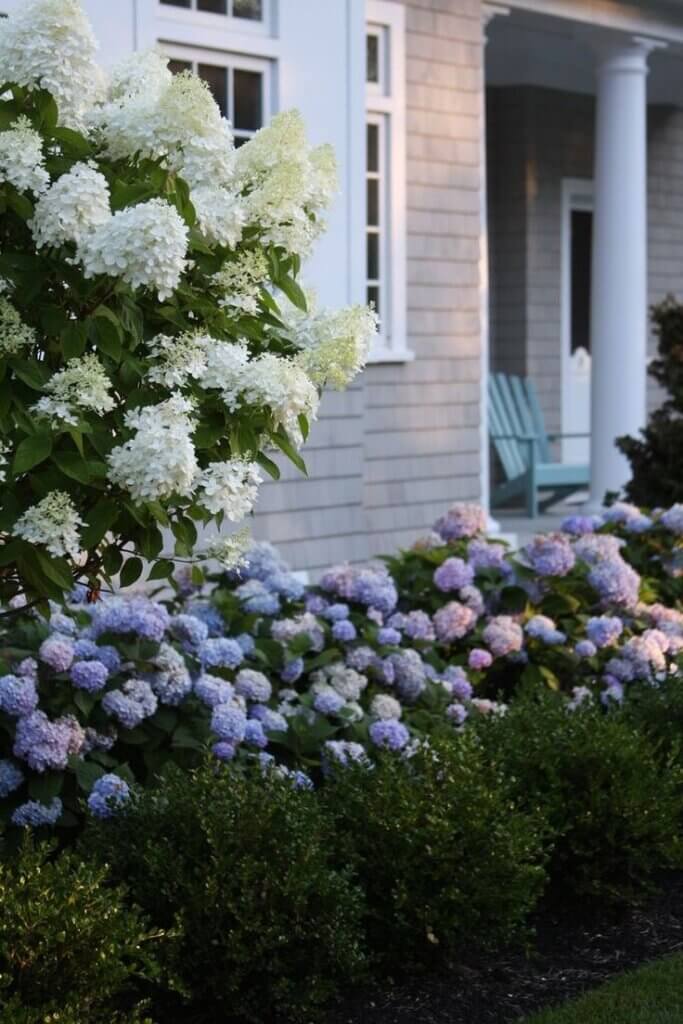
This arrangement reminds me of the English Garden. It’s neat, elegant but romantic at the same time. We have here two varieties of Hydrangeas: Hydrangea paniculata (likely ‘Limelight’ or similar) with white cone-shaped flowers and Bigleaf Hydrangea with round blue mophead flowers.
As a border for this bed we see Boxwood shrubs, they provide structure and year-round interest in the foreground.
You may also like: 10 Beautiful Ideas for Spring Flower Pots
15. Pop of white in green formal garden
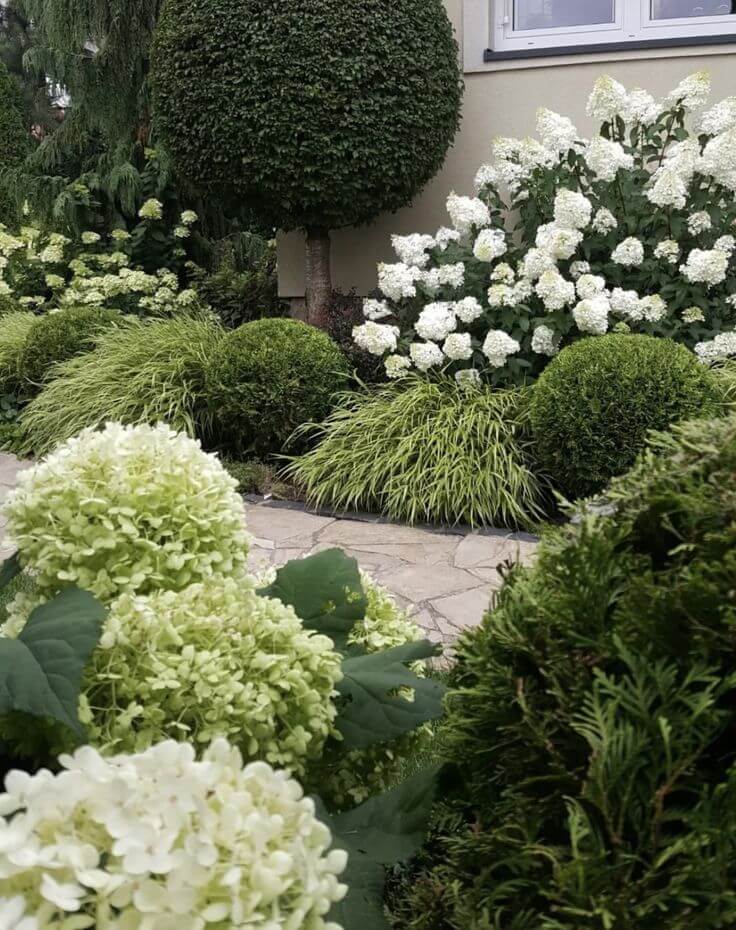
This is a classic example of mixing formal elements with informal plants to create an elegant but not overly rigid garden design.
We have here two types of Hydrangeas: probably ‘Limelight’ (round green flower heads) and ‘Polar Bear’ with cone-like flowers. In front of it we see Japanese Forest Grass (Hakonechloa macra). Its graceful, arching golden-green foliage provides flowing texture between structured elements.
We get some structure from Boxwood trained as a standard tree form and formal sphere-shaped topiaries of Cedar.
16. Hydrangeas in pots for steps decor
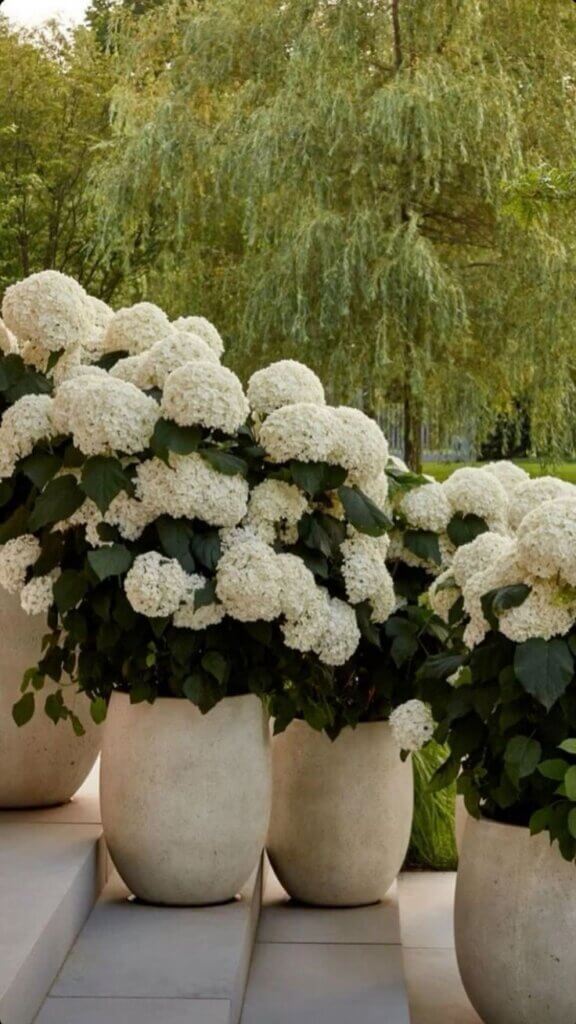
Like I’ve said before Hydrangeas do well in containers. In this case we have Hydrangea arborescens ‘Annabelle’ planted in elegant, neutral-toned ceramic pots, which complement their lush green foliage and delicate white blooms. The pots also compliment the stairs and create an elegant and cohesive look.
17. What old Hydrangea looks like
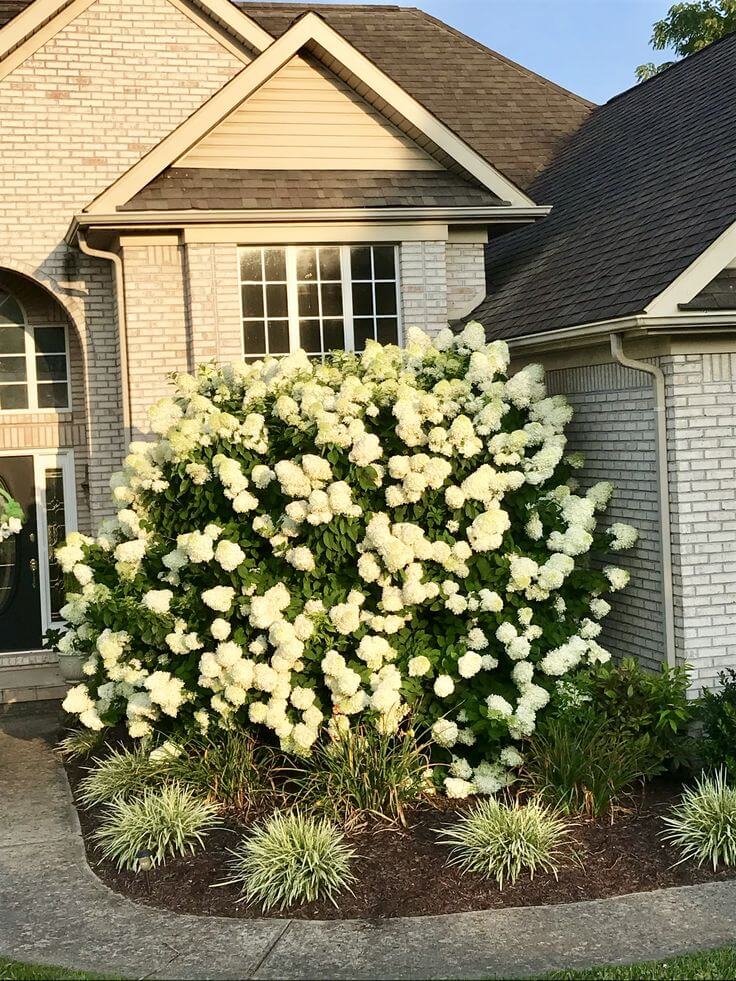
If You’ve ever wondered what your Hydrangea will age with time, here is a perfect example of a happy and old Hydrangea shrub. We usually see shrubs that aren’t taller than an average person, so something like that is really amazing.
Here we have Hydrangea paniculata ‘Limelight’.This type of hydrangea is known for its upright growth habit and strong stems, making it a popular choice for landscaping. Surrounding the Hydrangea, there are ornamental grasses, likely a variety of Liriope (Liriope muscari) or variegated Carex, which add texture and contrast to the garden bed.
18. Energetic combination of Hydrangeas and Lilies
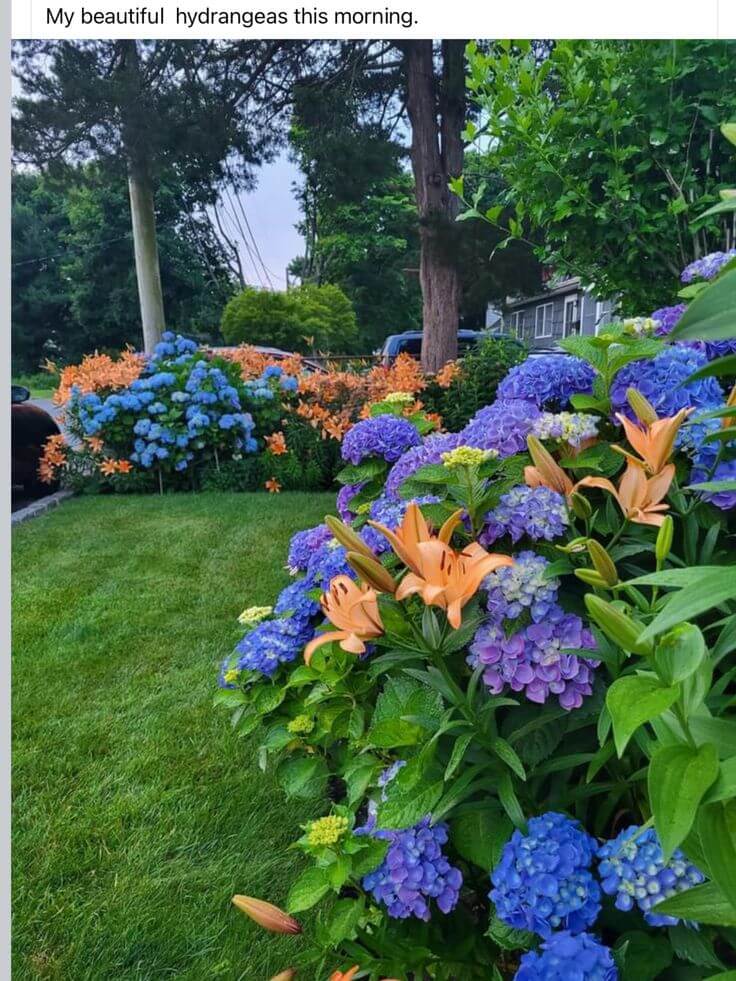
This combination creates a dynamic and colorful garden, not seen very often. This energetic combo includes blue Bigleaf Hydrangeas, known for their vibrant blue and purple shades and Orange Asiatic Lilies. These striking orange flowers with upward-facing blooms contrast beautifully with the hydrangeas. Asiatic lilies are known for their hardy nature and bright summer blossoms.
19. Hydrangeas in woodland garden
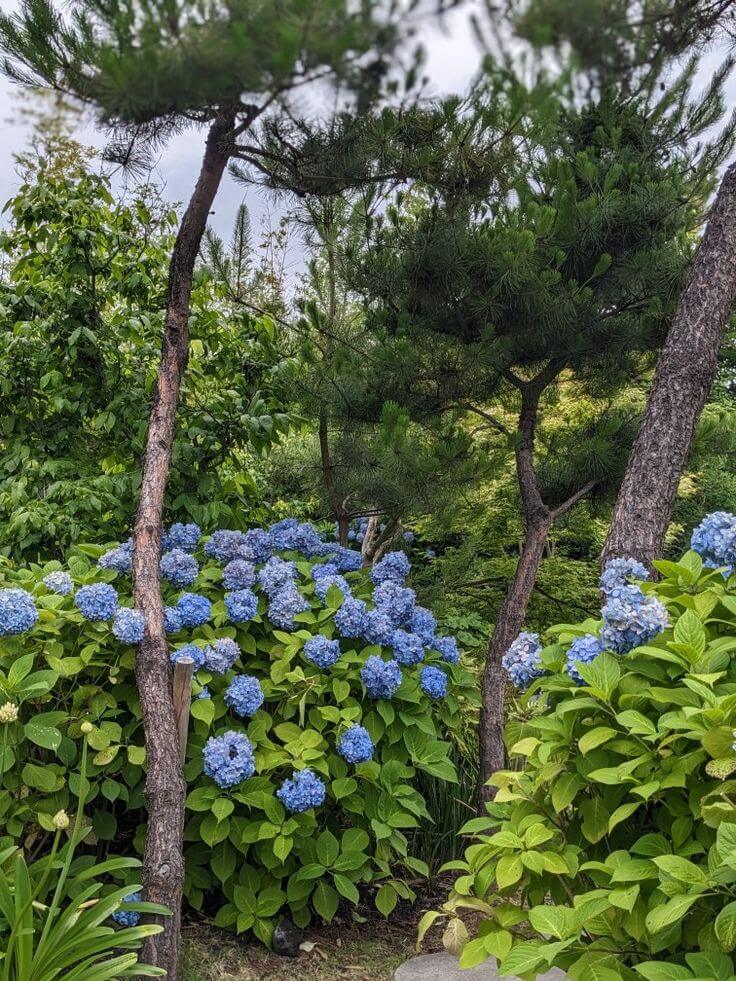
This woodland-style garden features Bigleaf Hydrangea and Pine Trees.
It may look odd at first but it’s actually quite a smart arrangement. Hydrangeas are thriving in the dappled shade provided by the pine trees. The blue color of the hydrangeas is particularly vibrant, suggesting the soil is quite acidic (which is common in pine forests due to the fallen needles naturally acidifying the soil). This is a classic example of working with natural conditions to create a beautiful garden scene.
20. Romantic view on Hydrangeas
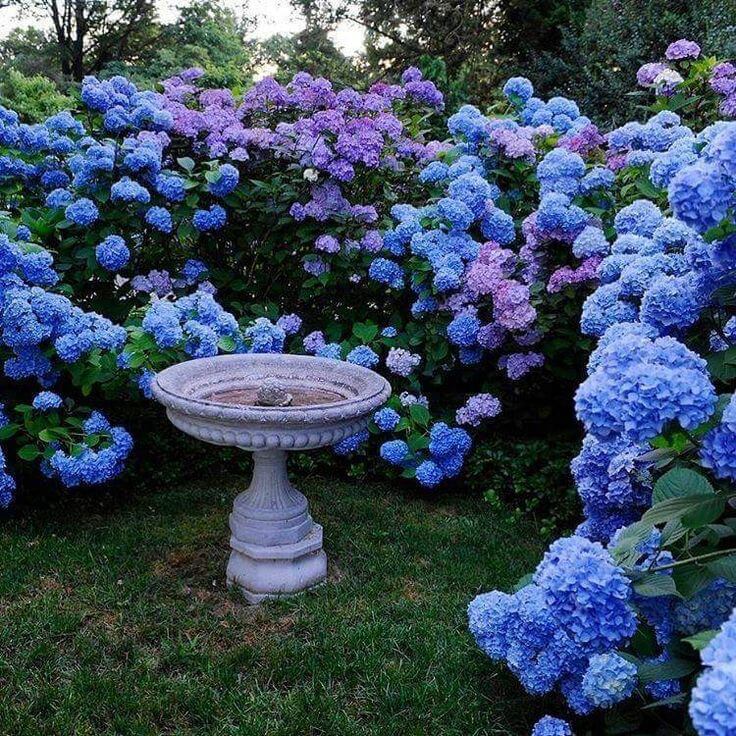
Last but not least we have a romantic corner of a garden. The beautiful mature Bigleaf Hydrangeas surround a classic stone birdbath in a focal point. This is a beautiful example of how hydrangeas can create a dramatic impact when mass-planted and when soil conditions are optimized for blue blooms. The varying shades of blue to purple create depth and interest in the planting.
Whether you’re drawn to the pristine white blooms of ‘Annabelle’, the moody blues of macrophylla, or the elegant transitions of ‘Vanilla Strawberry’, hydrangeas offer endless possibilities for garden design. Pair them with structured evergreens for year-round interest, let them dance with lavender for a cottage garden feel, or create dramatic mass plantings for show-stopping impact. From formal foundation plantings to woodland gardens, these versatile shrubs prove that sometimes the best garden inspiration comes from classic favorites that have enchanted gardeners for generations.